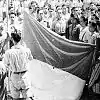Yogyakarta and Surakarta Offensive
The Yogyakarta and Surakarta Offensive (Serangan Oemoem: Indonesian) were two major offensives during the Indonesian National Revolution. The offensive started with General Offensive of 1 March 1949 and the Siege of Surakarta. Each proved a major boast for the moral of the TNI despite major defeats in both actions.
| Yogyakarta and Surakarta | |||||||
|---|---|---|---|---|---|---|---|
| Part of Indonesian National Revolution | |||||||
| |||||||
| Belligerents | |||||||
|
|
Royal Netherlands East Indies Army | ||||||
| Commanders and leaders | |||||||
|
Hamengkubuwono IX General Soedirman Colonel Bambang Soegeng Lieutenant Colonel Suharto Lieutenant Colonel Slamet Riyadi |
Major General Dirk Reinhard Adelbert van Langen Major General Meyer Lieutenant Colonel J.M. v/d Berge Lieutenant Colonel Johannes Borghouts | ||||||
| Strength | |||||||
| 20,000–40,000 |
2,000–3,000 Royal Netherlands Army and Royal Netherlands East Indies Army 325 KST troops | ||||||
| Casualties and losses | |||||||
| ~800–900 dead, among them an unknown number of non-combatants | 3 soldiers were killed and 3 policemen, 14 soldiers got injured,3 RST troops wounded | ||||||
General Offensive of 1 March 1949
In early 1949, Hamengkubuwono IX conceived the idea of a major offensive to be launched against Yogyakarta and the Dutch troops occupying it. The purpose of this offensive was to show to the world that Indonesia still existed and that it was not ready to surrender. The Offensive caught the Dutch by surprise. For his part, Hamengkubuwono IX allowed his palace to be used as a hide out for the troops. For 6 hours, the Indonesian troops had control of Yogyakarta before finally retreating. The offensive was a moral success, inspiring demoralized troops all around Indonesia. It failed in its attempt to show the world that the Indonesian army still existed. Not much attention was paid to it by the United Nations.
Surakarta insurgency
The Tentara Republik Indonesia made an attempt before the armistice, to get hands on Surakarta in Central Java and succeeded in many places to infiltrate the city. 325 men of the RST were hastily flown in to expel the TNI from Surakarta. In a few days time the insurgency was carried out. Approximately 400 members of the TNI were killed, while the RST numbered only three wounded. It can not be entirely ruled out that a number of civilian casualties have been counted among the losses of the TNI.
Aftermath
This last battle of the RST showed again the qualitative superiority of the KST/RST on the Indonesian nationalist fighters. The leader of the raid on Surakarta on August 7, 1949 was Lieutenant Colonel Slamet Riyadi. To commemorate this event, the main street of the city of Surakarta was renamed "Brigadier General Slamet Riyadi Street".
